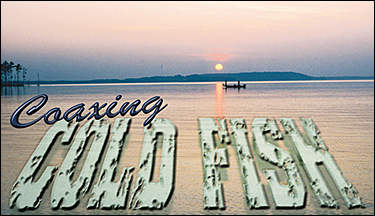
By Paul A. Cañada
Page 2
Principle Two: Slow down and then fish slower
The secret to the suspend-doodle rig's effectiveness is its ability to stay in the sluggish bass' strike zone longer. In fact, the presentation seems to work best when it's nearly dead-sticked along the bottom.
According to Harris a natural looking bait, slowly worked through the water column or along the bottom, is often critical to drawing the tough winter bite.
"Unless frightened, everything that swims or moves through the water moves slowly and deliberately," Harris explains. "When you can catch bass on a reaction bait, fishing slowly isn't always the most efficient way to catch them. However, when bass are inactive and so unwilling to
give chase, a slowed down approach is often the only way to catch them."
The Fort Worth angler concedes that fishing slowly is often more important than presenting a small profile. He points out that some of the better cold-water anglers catch good numbers of fish on short-arm spinnerbaits slow-rolled near the bottom, and 10-inch worms slowly stitched along the bottom. Although bass do feed during the cold-water period, he believes the fish spend most of their time conserving metabolic energy.
"Fishery biologists tell us that bass are actively feeding only 10 percent of the time," he adds. "If that's true it doesn't take much smarts to see that the odds are stacked against the bass being active when I am on the water. Because of this, I simply assume the bass are inactive and so fish small baits-slowly."
Another Harris favorite is the "slip-shot" presentation. According to him the slip-shot rig is similar to the split-shotin' presentation popular out west. However, instead of using a crimped split shot, Harris' slip-shot rig uses a Top Brass Peg-It to peg either the slip sinker or glass bead.
"When using the Peg-It," he explains, "I am able to effectively change the presentation without re-rigging. I simply move the slip-shot rig's sliding sinker up or down the line. I can slide the weight 3 feet above the bait and it becomes a Carolina rig, or slide it down to the hook eye and it becomes a Texas rig. When I place the weight 10 to 12 inches above the hook, it fishes like a split shot rig."
Principle Three: Find a triggering mechanism
Because the slip-shot rig forces the angler to slow down-especially when fished in relatively deep water-it certainly fits Harris' second finesse principle. However, Harris believes the rig's lifelike action is the key to triggering the reluctant bite. And so the slip-shot also adheres to Harris' third and final principle; find a triggering mechanism.
The Fort Worth tackle rep relies on a number of triggering mechanisms-flash, noise, and lifelike movement-to draw the sluggish bite. Some of the most popular cold-water presentations-tail-spinners, spinnerbaits, crankbaits and spoons-combine flash and noise. Still, during the cold-water period, the lifelike, injured and struggling action of a bait sliding, suspending or falling is the most effective drawing card of all.
In the case of Harris' slip-shot presentation, the triggering mechanism is the lure's changing rate of fall. As is the case with most plastic bait rigs, the lure falls at the same rate the weight falls. However, when the slip-shot rig's weight hits bottom, the trailing plastic's fall rate slows. The lure appears to pause or hesitate and then continue down slowly. According to Harris, that little hesitation triggers the strike.
The slip-shot rig's wandering way is similar to the slide or glide of a hand-poured worm. Another finesse presentation that effectively draws the tough cold-water bite is the Charlie Brewer's Slider jig head. The specially designed lead head jigs cause finesse-sized worms to literally glide through the water column. The slow, horizontal fall of a Charlie Brewer-rigged worm will often pull inactive bass from cover.
"When the bite is tough or the fish are lethargic," Harris concludes, "you need something that will trigger a strike. That usually means doing something different with the retrieve to make it look injured. You have to convince the bass that your bait is an easy meal."
# # # #
page 1 / page 2
| 




